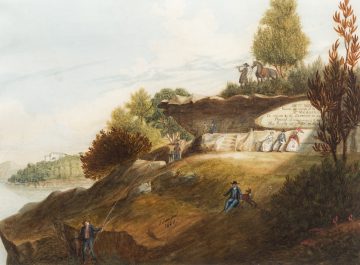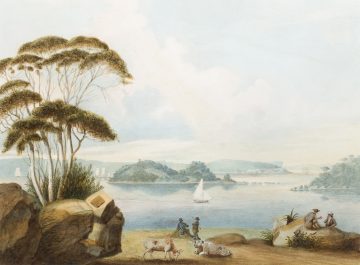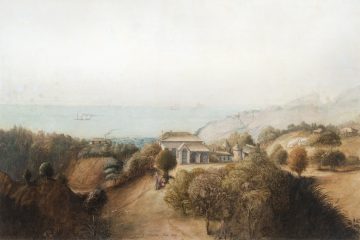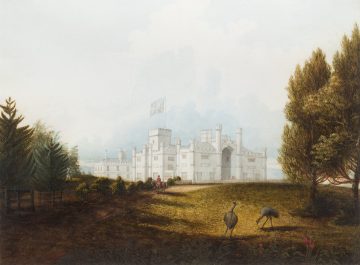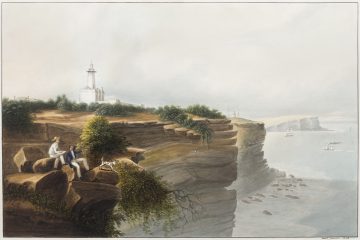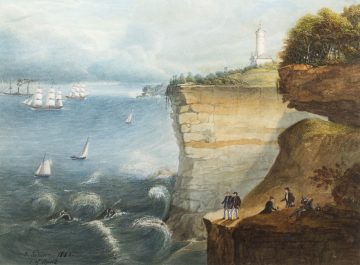Jacob Janssen (1779 – 1856)

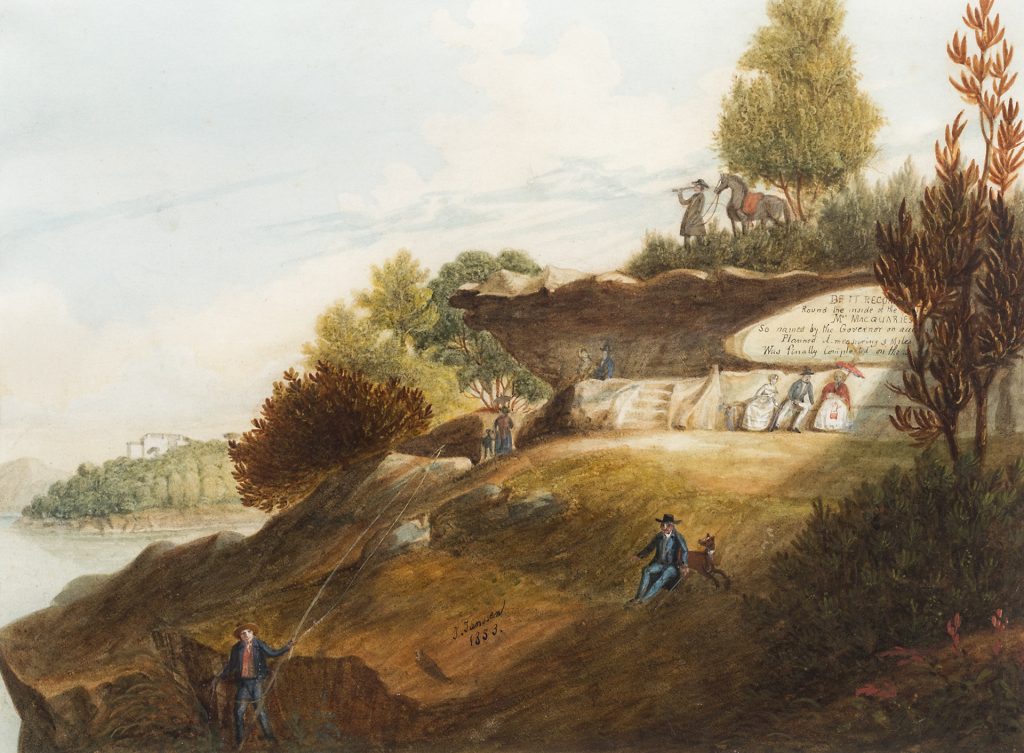
Collection of fine mid-19th Century watercolours presenting views of Sydney (1/6)
watercolour on paper
23.5 x 31.5 cm
Provenance
Private collection, NSW
Essay
Jacob Janssen (also known as Jacob Jansen or Jacob Janssens) produced charming and detailed watercolour images of mid-19thCentury Sydney. Born in 1779 in Prussia, and trained under Signor Piesio Ancora of the School of Naples, Janssen went on to travel extensively and record detailed descriptions of the places he visited in a diary that he kept his entire life. As he gained acclaim as a painter, his landscapes, portraits and portrayals of contemporary political events added to this record of life in the colonies.
In 1807, at the age of just 28, Janssen embarked on his first voyage, which eventually took him to the United States. There he worked as a sign painter and glazier. In 1815 he returned to Germany but by 1819 was aboard a ship bound for Rio de Janeiro, once more destined for the New World. As Candice Bruce has noted in her biography of the artist[1], Janssen remained in Brazil for twelve years, possibly with a connection to the royal court of Dom Pedro. It is also likely that a romantic interest kept him in Brazil during this period, with a telling 1821 reference in his diary to ‘love stealing his heart with a pair of black eyes.’[2]
Australia’s Mitchell Library holds a number of Janssen’s sketches from his time in Brazil, as well as two watercolours from his subsequent visit to Calcutta, India: an undated panorama of that city and A Pepul Tree on Garden Rear of Road(1836).[3]In British colonial India Janssen took a painting commission and taught drawing, before setting sail again for Singapore. An inveterate adventurer, the artist travelled extensively, also visiting Zanzibar and the Philippines.
By 1840, Janssen was aboard the Louisa Campbellsailing for Sydney, where he arrived on the 5thof December. Here he found acclaim for his watercolour landscapes and portraits, with the Sydney Gazette making note in 1841 of his ‘beautiful specimens of landscape painting in watercolours’.[4]While Janssen painted a small number of oils on canvas in the early to mid-1840s, such as Panorama of Sydney Harbour with Government House and Fort Macquarie from Mrs Macquarie’s Chair(c. 1895, the collection of the Art Gallery of South Australia), his most successful pictures were his delicately crafted watercolours.
Views of Sydney were a popular subject for Janssen, who remained in the colony for sixteen years, until his death in 1856. Most are held in public collections and examples do not often appear on the market.
Janssen and his work slipped into relative obscurity following his death at the age of 77. In recent decades, however, fresh interest and research has shown that he was a significant figure in the colonial Sydney art world of his time. Six of his works were included in the Art Gallery of New South Wales’ The Artist and the Patronexhibition of 1988, with one selected to feature on the exhibition catalogue cover.[5]A major article on Janssen appeared in Art and Australiain 1989[6]and his watercolour depictions of early colonial life in Sydney continue to fascinate scholars and collectors alike.
[1]Bruce, C., 1992, Jacob Janssen, Dictionary of Australian Artists Online, available: https://www.daao.org.au/bio/jacob-janssen/biography/
[5]McDonald, P.R. and Pearce, B., 1988, The Artist and the Patron, Art Gallery of New South Wales, Sydney
[6]Bruce, C., ‘Jacob Janssen in Sydney’, Art and Australia, Vol. 26, No. 3, Autumn 1989, pp. 406 – 411

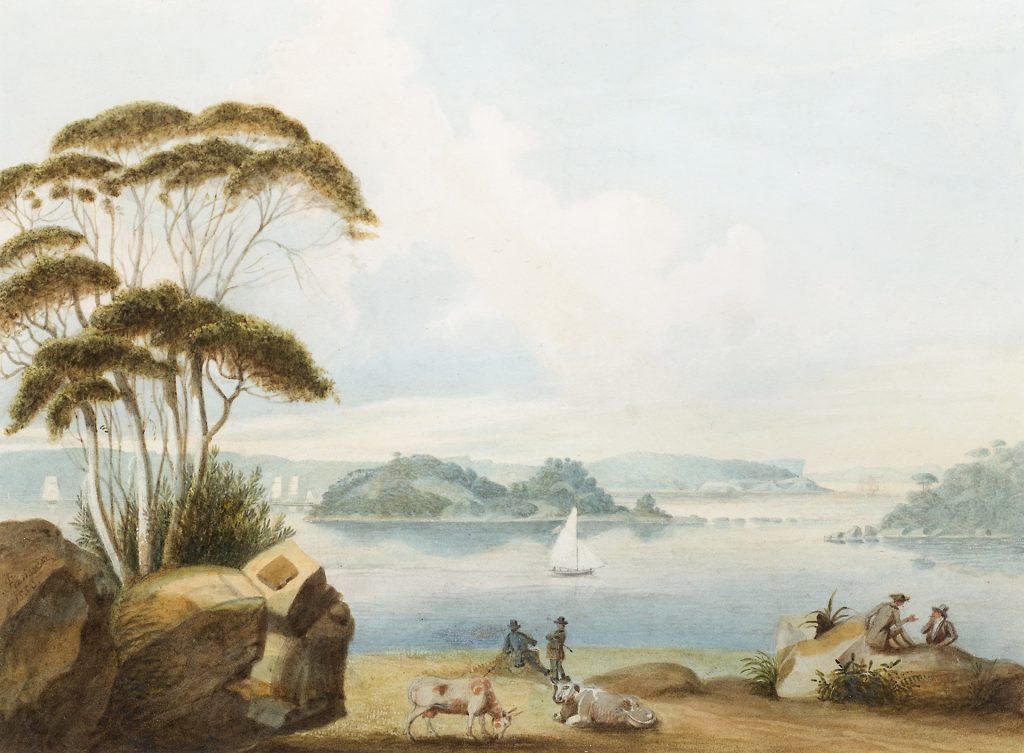
Collection of fine mid-19th Century watercolours presenting views of Sydney (2/6)
watercolour on paper
25 x 34.5 cm
Provenance
Private collection, NSW
Essay
Jacob Janssen (also known as Jacob Jansen or Jacob Janssens) produced charming and detailed watercolour images of mid-19thCentury Sydney. Born in 1779 in Prussia, and trained under Signor Piesio Ancora of the School of Naples, Janssen went on to travel extensively and record detailed descriptions of the places he visited in a diary that he kept his entire life. As he gained acclaim as a painter, his landscapes, portraits and portrayals of contemporary political events added to this record of life in the colonies.
In 1807, at the age of just 28, Janssen embarked on his first voyage, which eventually took him to the United States. There he worked as a sign painter and glazier. In 1815 he returned to Germany but by 1819 was aboard a ship bound for Rio de Janeiro, once more destined for the New World. As Candice Bruce has noted in her biography of the artist[1], Janssen remained in Brazil for twelve years, possibly with a connection to the royal court of Dom Pedro. It is also likely that a romantic interest kept him in Brazil during this period, with a telling 1821 reference in his diary to ‘love stealing his heart with a pair of black eyes.’[2]
Australia’s Mitchell Library holds a number of Janssen’s sketches from his time in Brazil, as well as two watercolours from his subsequent visit to Calcutta, India: an undated panorama of that city and A Pepul Tree on Garden Rear of Road(1836).[3]In British colonial India Janssen took a painting commission and taught drawing, before setting sail again for Singapore. An inveterate adventurer, the artist travelled extensively, also visiting Zanzibar and the Philippines.
By 1840, Janssen was aboard the Louisa Campbellsailing for Sydney, where he arrived on the 5thof December. Here he found acclaim for his watercolour landscapes and portraits, with the Sydney Gazette making note in 1841 of his ‘beautiful specimens of landscape painting in watercolours’.[4]While Janssen painted a small number of oils on canvas in the early to mid-1840s, such as Panorama of Sydney Harbour with Government House and Fort Macquarie from Mrs Macquarie’s Chair(c. 1895, the collection of the Art Gallery of South Australia), his most successful pictures were his delicately crafted watercolours.
Views of Sydney were a popular subject for Janssen, who remained in the colony for sixteen years, until his death in 1856. Most are held in public collections and examples do not often appear on the market.
Janssen and his work slipped into relative obscurity following his death at the age of 77. In recent decades, however, fresh interest and research has shown that he was a significant figure in the colonial Sydney art world of his time. Six of his works were included in the Art Gallery of New South Wales’ The Artist and the Patronexhibition of 1988, with one selected to feature on the exhibition catalogue cover.[5]A major article on Janssen appeared in Art and Australiain 1989[6]and his watercolour depictions of early colonial life in Sydney continue to fascinate scholars and collectors alike.
[1]Bruce, C., 1992, Jacob Janssen, Dictionary of Australian Artists Online, available: https://www.daao.org.au/bio/jacob-janssen/biography/
[5]McDonald, P.R. and Pearce, B., 1988, The Artist and the Patron, Art Gallery of New South Wales, Sydney
[6]Bruce, C., ‘Jacob Janssen in Sydney’, Art and Australia, Vol. 26, No. 3, Autumn 1989, pp. 406 – 411

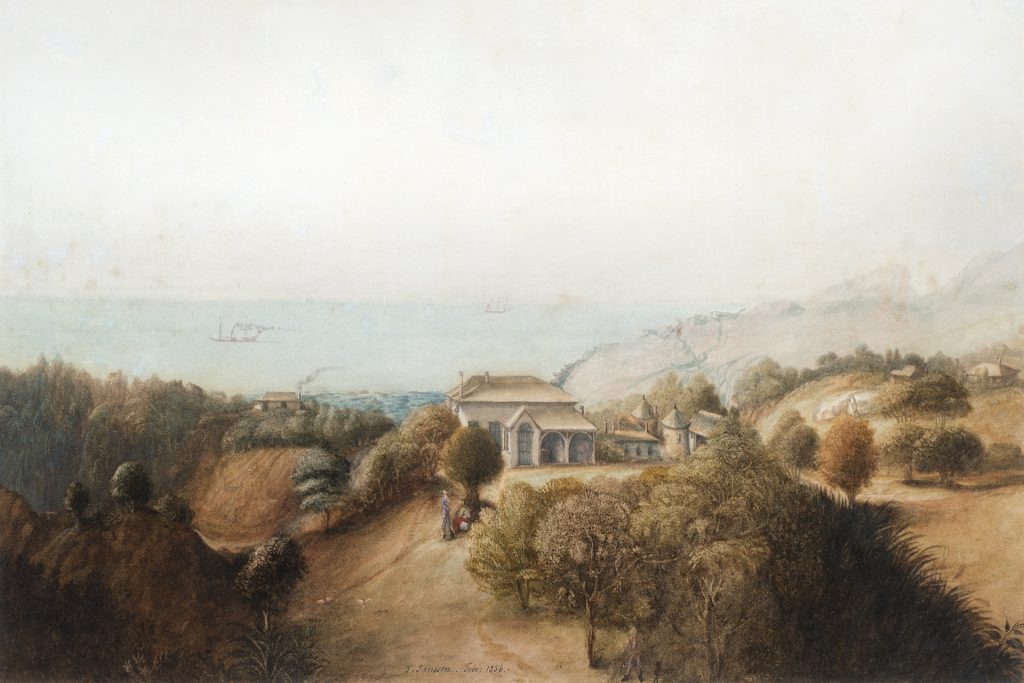
Collection of fine mid-19th Century watercolours presenting views of Sydney (3/6)
watercolour on paper
31 x 52.5 cm
Provenance
Private collection, NSW
Essay
Jacob Janssen (also known as Jacob Jansen or Jacob Janssens) produced charming and detailed watercolour images of mid-19thCentury Sydney. Born in 1779 in Prussia, and trained under Signor Piesio Ancora of the School of Naples, Janssen went on to travel extensively and record detailed descriptions of the places he visited in a diary that he kept his entire life. As he gained acclaim as a painter, his landscapes, portraits and portrayals of contemporary political events added to this record of life in the colonies.
In 1807, at the age of just 28, Janssen embarked on his first voyage, which eventually took him to the United States. There he worked as a sign painter and glazier. In 1815 he returned to Germany but by 1819 was aboard a ship bound for Rio de Janeiro, once more destined for the New World. As Candice Bruce has noted in her biography of the artist[1], Janssen remained in Brazil for twelve years, possibly with a connection to the royal court of Dom Pedro. It is also likely that a romantic interest kept him in Brazil during this period, with a telling 1821 reference in his diary to ‘love stealing his heart with a pair of black eyes.’[2]
Australia’s Mitchell Library holds a number of Janssen’s sketches from his time in Brazil, as well as two watercolours from his subsequent visit to Calcutta, India: an undated panorama of that city and A Pepul Tree on Garden Rear of Road(1836).[3]In British colonial India Janssen took a painting commission and taught drawing, before setting sail again for Singapore. An inveterate adventurer, the artist travelled extensively, also visiting Zanzibar and the Philippines.
By 1840, Janssen was aboard the Louisa Campbellsailing for Sydney, where he arrived on the 5thof December. Here he found acclaim for his watercolour landscapes and portraits, with the Sydney Gazette making note in 1841 of his ‘beautiful specimens of landscape painting in watercolours’.[4]While Janssen painted a small number of oils on canvas in the early to mid-1840s, such as Panorama of Sydney Harbour with Government House and Fort Macquarie from Mrs Macquarie’s Chair(c. 1895, the collection of the Art Gallery of South Australia), his most successful pictures were his delicately crafted watercolours.
Views of Sydney were a popular subject for Janssen, who remained in the colony for sixteen years, until his death in 1856. Most are held in public collections and examples do not often appear on the market.
Janssen and his work slipped into relative obscurity following his death at the age of 77. In recent decades, however, fresh interest and research has shown that he was a significant figure in the colonial Sydney art world of his time. Six of his works were included in the Art Gallery of New South Wales’ The Artist and the Patronexhibition of 1988, with one selected to feature on the exhibition catalogue cover.[5]A major article on Janssen appeared in Art and Australiain 1989[6]and his watercolour depictions of early colonial life in Sydney continue to fascinate scholars and collectors alike.
[1]Bruce, C., 1992, Jacob Janssen, Dictionary of Australian Artists Online, available: https://www.daao.org.au/bio/jacob-janssen/biography/
[5]McDonald, P.R. and Pearce, B., 1988, The Artist and the Patron, Art Gallery of New South Wales, Sydney
[6]Bruce, C., ‘Jacob Janssen in Sydney’, Art and Australia, Vol. 26, No. 3, Autumn 1989, pp. 406 – 411

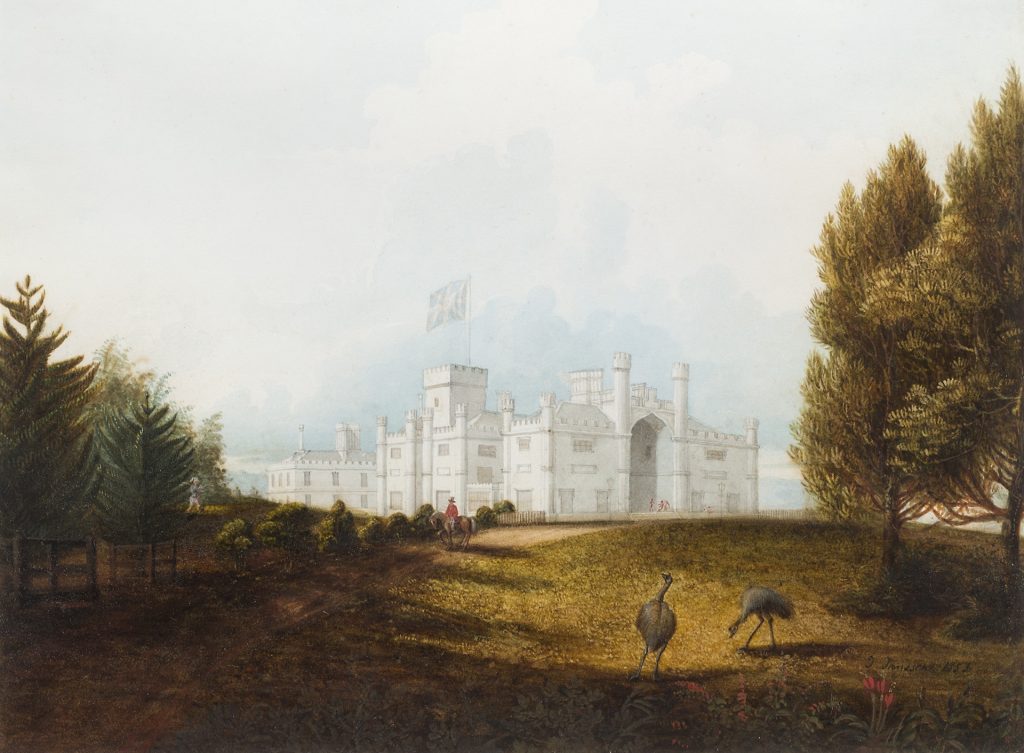
Collection of fine mid-19th Century watercolours presenting views of Sydney (4/6)
watercolour on paper
25 x 34 cm
Provenance
Private collection, NSW
Essay
Jacob Janssen (also known as Jacob Jansen or Jacob Janssens) produced charming and detailed watercolour images of mid-19thCentury Sydney. Born in 1779 in Prussia, and trained under Signor Piesio Ancora of the School of Naples, Janssen went on to travel extensively and record detailed descriptions of the places he visited in a diary that he kept his entire life. As he gained acclaim as a painter, his landscapes, portraits and portrayals of contemporary political events added to this record of life in the colonies.
In 1807, at the age of just 28, Janssen embarked on his first voyage, which eventually took him to the United States. There he worked as a sign painter and glazier. In 1815 he returned to Germany but by 1819 was aboard a ship bound for Rio de Janeiro, once more destined for the New World. As Candice Bruce has noted in her biography of the artist[1], Janssen remained in Brazil for twelve years, possibly with a connection to the royal court of Dom Pedro. It is also likely that a romantic interest kept him in Brazil during this period, with a telling 1821 reference in his diary to ‘love stealing his heart with a pair of black eyes.’[2]
Australia’s Mitchell Library holds a number of Janssen’s sketches from his time in Brazil, as well as two watercolours from his subsequent visit to Calcutta, India: an undated panorama of that city and A Pepul Tree on Garden Rear of Road(1836).[3]In British colonial India Janssen took a painting commission and taught drawing, before setting sail again for Singapore. An inveterate adventurer, the artist travelled extensively, also visiting Zanzibar and the Philippines.
By 1840, Janssen was aboard the Louisa Campbellsailing for Sydney, where he arrived on the 5thof December. Here he found acclaim for his watercolour landscapes and portraits, with the Sydney Gazette making note in 1841 of his ‘beautiful specimens of landscape painting in watercolours’.[4]While Janssen painted a small number of oils on canvas in the early to mid-1840s, such as Panorama of Sydney Harbour with Government House and Fort Macquarie from Mrs Macquarie’s Chair(c. 1895, the collection of the Art Gallery of South Australia), his most successful pictures were his delicately crafted watercolours.
Views of Sydney were a popular subject for Janssen, who remained in the colony for sixteen years, until his death in 1856. Most are held in public collections and examples do not often appear on the market.
Janssen and his work slipped into relative obscurity following his death at the age of 77. In recent decades, however, fresh interest and research has shown that he was a significant figure in the colonial Sydney art world of his time. Six of his works were included in the Art Gallery of New South Wales’ The Artist and the Patronexhibition of 1988, with one selected to feature on the exhibition catalogue cover.[5]A major article on Janssen appeared in Art and Australiain 1989[6]and his watercolour depictions of early colonial life in Sydney continue to fascinate scholars and collectors alike.
[1]Bruce, C., 1992, Jacob Janssen, Dictionary of Australian Artists Online, available: https://www.daao.org.au/bio/jacob-janssen/biography/
[5]McDonald, P.R. and Pearce, B., 1988, The Artist and the Patron, Art Gallery of New South Wales, Sydney
[6]Bruce, C., ‘Jacob Janssen in Sydney’, Art and Australia, Vol. 26, No. 3, Autumn 1989, pp. 406 – 411

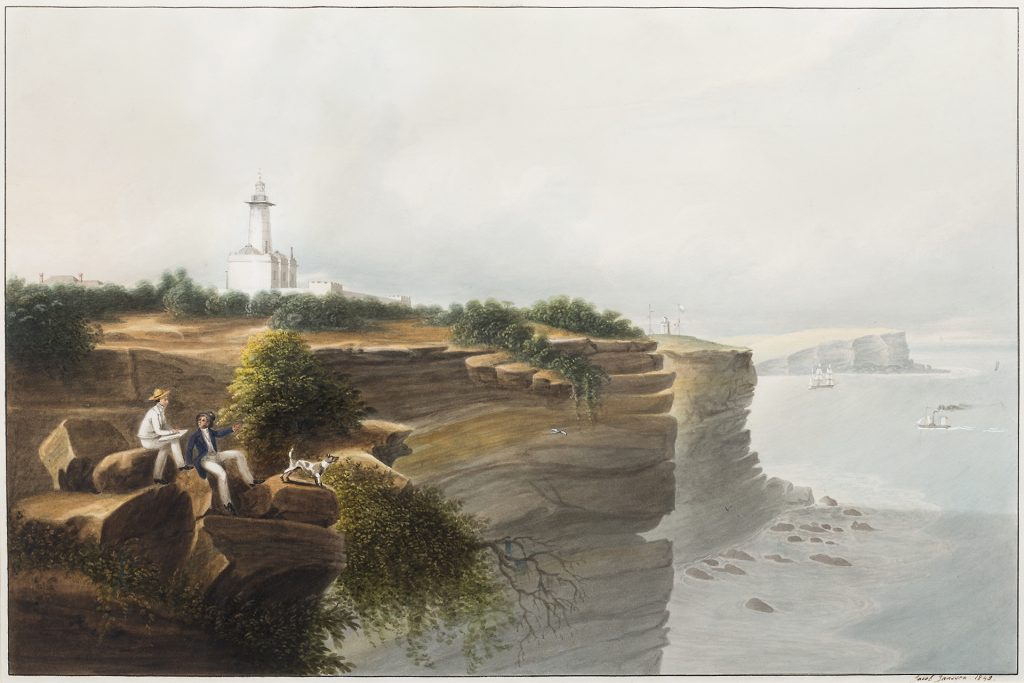
Collection of fine mid-19th Century watercolours presenting views of Sydney (5/6)
watercolour on paper
30 x 44 cm
Provenance
Private collection, NSW
Essay
Jacob Janssen (also known as Jacob Jansen or Jacob Janssens) produced charming and detailed watercolour images of mid-19thCentury Sydney. Born in 1779 in Prussia, and trained under Signor Piesio Ancora of the School of Naples, Janssen went on to travel extensively and record detailed descriptions of the places he visited in a diary that he kept his entire life. As he gained acclaim as a painter, his landscapes, portraits and portrayals of contemporary political events added to this record of life in the colonies.
In 1807, at the age of just 28, Janssen embarked on his first voyage, which eventually took him to the United States. There he worked as a sign painter and glazier. In 1815 he returned to Germany but by 1819 was aboard a ship bound for Rio de Janeiro, once more destined for the New World. As Candice Bruce has noted in her biography of the artist[1], Janssen remained in Brazil for twelve years, possibly with a connection to the royal court of Dom Pedro. It is also likely that a romantic interest kept him in Brazil during this period, with a telling 1821 reference in his diary to ‘love stealing his heart with a pair of black eyes.’[2]
Australia’s Mitchell Library holds a number of Janssen’s sketches from his time in Brazil, as well as two watercolours from his subsequent visit to Calcutta, India: an undated panorama of that city and A Pepul Tree on Garden Rear of Road(1836).[3]In British colonial India Janssen took a painting commission and taught drawing, before setting sail again for Singapore. An inveterate adventurer, the artist travelled extensively, also visiting Zanzibar and the Philippines.
By 1840, Janssen was aboard the Louisa Campbellsailing for Sydney, where he arrived on the 5thof December. Here he found acclaim for his watercolour landscapes and portraits, with the Sydney Gazette making note in 1841 of his ‘beautiful specimens of landscape painting in watercolours’.[4]While Janssen painted a small number of oils on canvas in the early to mid-1840s, such as Panorama of Sydney Harbour with Government House and Fort Macquarie from Mrs Macquarie’s Chair(c. 1895, the collection of the Art Gallery of South Australia), his most successful pictures were his delicately crafted watercolours.
Views of Sydney were a popular subject for Janssen, who remained in the colony for sixteen years, until his death in 1856. Most are held in public collections and examples do not often appear on the market.
Janssen and his work slipped into relative obscurity following his death at the age of 77. In recent decades, however, fresh interest and research has shown that he was a significant figure in the colonial Sydney art world of his time. Six of his works were included in the Art Gallery of New South Wales’ The Artist and the Patronexhibition of 1988, with one selected to feature on the exhibition catalogue cover.[5]A major article on Janssen appeared in Art and Australiain 1989[6]and his watercolour depictions of early colonial life in Sydney continue to fascinate scholars and collectors alike.
[1]Bruce, C., 1992, Jacob Janssen, Dictionary of Australian Artists Online, available: https://www.daao.org.au/bio/jacob-janssen/biography/
[5]McDonald, P.R. and Pearce, B., 1988, The Artist and the Patron, Art Gallery of New South Wales, Sydney
[6]Bruce, C., ‘Jacob Janssen in Sydney’, Art and Australia, Vol. 26, No. 3, Autumn 1989, pp. 406 – 411

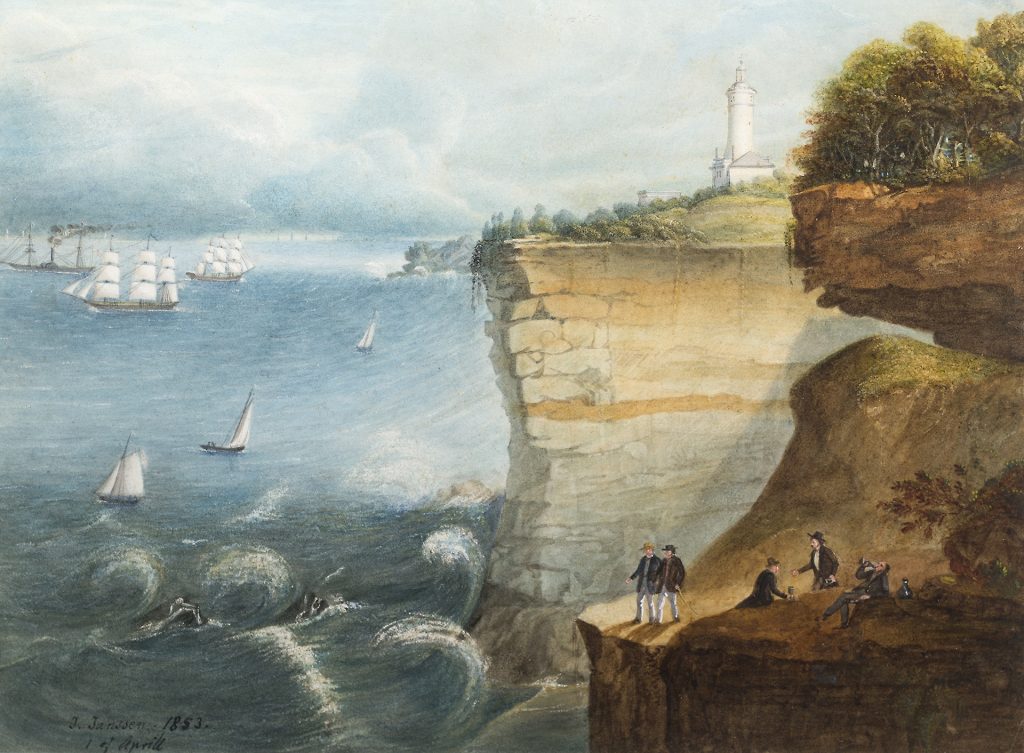
Collection of fine mid-19th Century watercolours presenting views of Sydney (6/6)
watercolour on paper
26 x 34 cm
Provenance
Private collection, NSW
Essay
Jacob Janssen (also known as Jacob Jansen or Jacob Janssens) produced charming and detailed watercolour images of mid-19thCentury Sydney. Born in 1779 in Prussia, and trained under Signor Piesio Ancora of the School of Naples, Janssen went on to travel extensively and record detailed descriptions of the places he visited in a diary that he kept his entire life. As he gained acclaim as a painter, his landscapes, portraits and portrayals of contemporary political events added to this record of life in the colonies.
In 1807, at the age of just 28, Janssen embarked on his first voyage, which eventually took him to the United States. There he worked as a sign painter and glazier. In 1815 he returned to Germany but by 1819 was aboard a ship bound for Rio de Janeiro, once more destined for the New World. As Candice Bruce has noted in her biography of the artist[1], Janssen remained in Brazil for twelve years, possibly with a connection to the royal court of Dom Pedro. It is also likely that a romantic interest kept him in Brazil during this period, with a telling 1821 reference in his diary to ‘love stealing his heart with a pair of black eyes.’[2]
Australia’s Mitchell Library holds a number of Janssen’s sketches from his time in Brazil, as well as two watercolours from his subsequent visit to Calcutta, India: an undated panorama of that city and A Pepul Tree on Garden Rear of Road(1836).[3]In British colonial India Janssen took a painting commission and taught drawing, before setting sail again for Singapore. An inveterate adventurer, the artist travelled extensively, also visiting Zanzibar and the Philippines.
By 1840, Janssen was aboard the Louisa Campbellsailing for Sydney, where he arrived on the 5thof December. Here he found acclaim for his watercolour landscapes and portraits, with the Sydney Gazette making note in 1841 of his ‘beautiful specimens of landscape painting in watercolours’.[4]While Janssen painted a small number of oils on canvas in the early to mid-1840s, such as Panorama of Sydney Harbour with Government House and Fort Macquarie from Mrs Macquarie’s Chair(c. 1895, the collection of the Art Gallery of South Australia), his most successful pictures were his delicately crafted watercolours.
Views of Sydney were a popular subject for Janssen, who remained in the colony for sixteen years, until his death in 1856. Most are held in public collections and examples do not often appear on the market.
Janssen and his work slipped into relative obscurity following his death at the age of 77. In recent decades, however, fresh interest and research has shown that he was a significant figure in the colonial Sydney art world of his time. Six of his works were included in the Art Gallery of New South Wales’ The Artist and the Patronexhibition of 1988, with one selected to feature on the exhibition catalogue cover.[5]A major article on Janssen appeared in Art and Australiain 1989[6]and his watercolour depictions of early colonial life in Sydney continue to fascinate scholars and collectors alike.
[1]Bruce, C., 1992, Jacob Janssen, Dictionary of Australian Artists Online, available: https://www.daao.org.au/bio/jacob-janssen/biography/
[5]McDonald, P.R. and Pearce, B., 1988, The Artist and the Patron, Art Gallery of New South Wales, Sydney
[6]Bruce, C., ‘Jacob Janssen in Sydney’, Art and Australia, Vol. 26, No. 3, Autumn 1989, pp. 406 – 411

